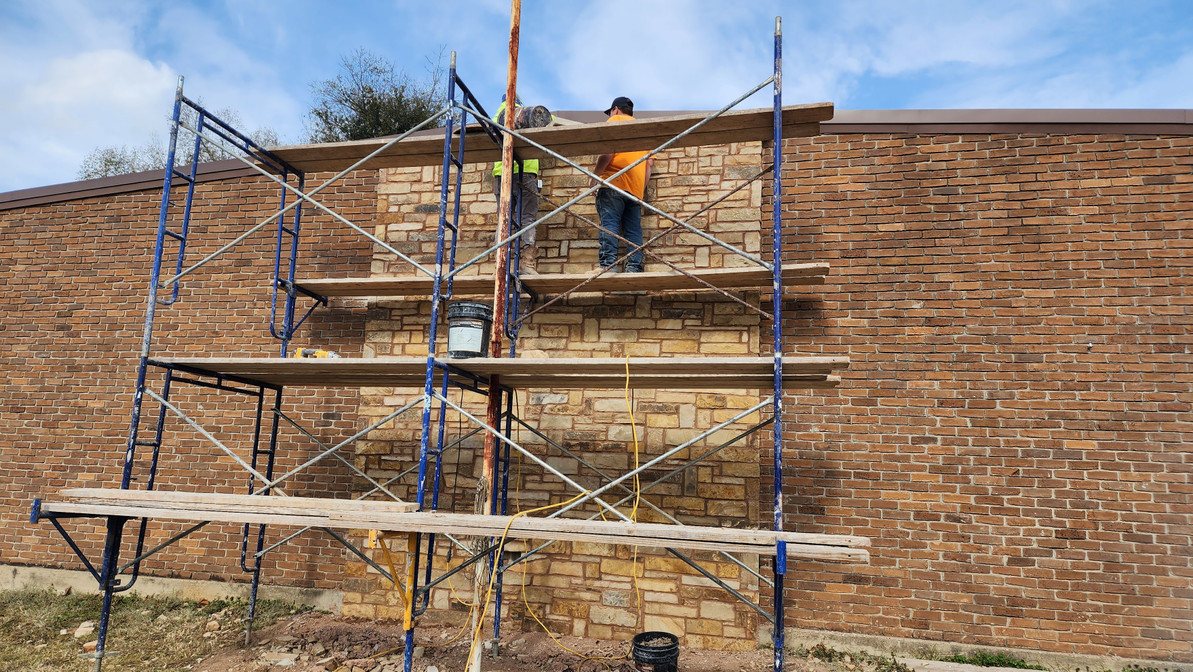Picking the Right scaffolding for your job
When it comes to construction, one of the most important aspects is building strong foundations. Whether you're constructing a single-story home or a towering skyscraper, having a solid structure is key to the success of your project. One of the most critical factors in building such a foundation is the type of scaffolding that you choose. Choosing the right scaffolding can make or break your construction project, and it's important to take the time to select the right type for the job at hand. In this blog post, we'll explore the different types of scaffolding available and provide some tips on how to select the right one for your construction project. So, grab your hard hat, and let's dive in!
Types of Scaffolding Systems
Scaffolding systems are essential for construction jobs, and choosing the right one is even more important. It is vital to know the various types of scaffolding systems available- supported, suspended, and mobile systems.
Supported Scaffolding
Supported scaffolding, as the name suggests, is erected from the ground level and is perfect for high-rise buildings. Its advantages include easy access to materials and tools, improved safety for workers, and good stability.
Suspended Scaffolding
On the other hand, suspended scaffolding is hung from the top of a building and is best suited for job sites where the ground cannot be disturbed. Its advantages include easy access to difficult-to-reach areas and quicker construction.
Mobile Scaffolding
Lastly, mobile scaffolding is ideal for smaller jobs where mobility is of the essence. It can be easily transported from one location to another, saving time and money. It is pertinent to choose the right scaffolding system that would cater to the specific needs of the job site in question. The factors to consider include the height of the building, the type of work to be done, and the weight-bearing capacity of the scaffolding system. In conclusion, selecting the appropriate scaffolding system can make all the difference in ensuring a successful and safe construction project."
How to Choose the Correct Scaffolding System for Your Job
Additionally, selecting the right type of scaffolding system is not only crucial for the success of the construction job but also for the safety of the workers involved. Choosing between supported, suspended, and mobile systems require careful consideration of the nature of the construction project, the weight of the materials, and the height requirements. With the right scaffolding system in place, work can be carried out efficiently, effortlessly, and, above all, safely. Moreover, selecting the right type of scaffolding system can dramatically improve SEO by reducing downtime, minimizing accidents, and increasing productivity. Therefore, it is essential to seek expert advice and choose the optimal scaffolding system that best fits the needs of your project to achieve maximum results.
The Benefits of Selecting the Right Scaffolding System
Scaffolding is an indispensable part of any construction project. It provides support and safety for workers as they carry out their tasks at height. However, choosing the right type of scaffolding for a specific job is crucial to ensure cost savings, increased efficiency, and improved safety. The three common types of scaffolding are supported, suspended, and mobile systems. Supported scaffolds are commonly used for outdoor projects like building exteriors, while suspended scaffolds are ideal for jobs that require access to the underside of structures such as bridges and dams. On the other hand, mobile scaffold systems are perfect for projects requiring easy transportation around the job site. When selecting the right type of scaffolding, it is essential to consider factors like the height of the structure, the weight of the materials to be carried, ease of erection and dismantling, and the type of terrain where the scaffold will be used. Proper selection and use of scaffolding can significantly reduce construction costs by making work easier, faster, and safer while avoiding potential accidents that could lead to delays, injury, or even death.
Supported Scaffolding Systems
Supported systems are ideal for larger job sites where access is limited. These systems are built using vertical poles or frames that provide sturdy support for workers and equipment. Supported systems are often used in high-rise construction projects because they provide a stable base for workers to operate from. They're also great for projects that require heavy equipment or materials, such as masonry work.
Suspended Scaffolding Systems
Suspended systems, on the other hand, are better suited for smaller job sites with limited access. These systems are hung from the top of a building or structure and allow workers to access areas that can't be reached by traditional scaffolding. Suspended systems are often used in window washing, painting, and maintenance work because they provide easy access to difficult-to-reach areas.
Mobile Scaffolding Systems
Finally, mobile systems work well in larger job sites where frequent access is needed. These systems are mounted on wheels or casters, making them easy to move from one location to another. Mobile systems are often used in construction projects that require workers to move around frequently, such as roofing or painting jobs.
Finally, it is important to remember that choosing the right type of scaffolding system can make all the difference when it comes to completing construction jobs safely and efficiently. Supported, suspended, and mobile systems each have their own unique benefits and drawbacks, so it is crucial to carefully consider the specific needs of your project before making a decision. By selecting a system that is appropriate for the job at hand, you can save time and money by reducing labor costs and ensuring that all necessary safety regulations are followed properly. So why settle for any old scaffolding when you can choose the right type and enjoy a job well done?
How to Choose the Correct Scaffolding System
Selecting the right type of scaffolding is a crucial decision for any construction job. It is imperative to take into account the environment in which the project is being completed. Indoor applications are best suited to supported systems, while outdoor applications are better suited to suspended and mobile systems. Supported systems are ideal for indoor projects as they offer a secure base for workers to operate from. However, when the construction site is outdoors, suspended and mobile systems are preferable as they provide greater flexibility and maneuverability. Suspended systems are particularly useful when working on high-rise buildings, while mobile systems are perfect for projects where the location changes frequently. When choosing between supported, suspended, and mobile systems, one should also pay attention to the load-bearing capacity, durability, and safety features of each system. Making the right choice can make all the difference in ensuring a successful construction project that is completed efficiently, safely, and effectively.
Scaffolding is a vital component of any construction project. Not only does it provide a safe and stable platform for workers, but it also allows for easy access to hard-to-reach areas. When selecting the right type of scaffolding, it's important to consider the specific needs of the job at hand. For example, if workers require access to all sides of a structure, a supported system would be the best choice. On the other hand, if access is only needed from one side, a suspended system may suffice. Mobile systems offer the most flexibility, as they can be easily moved around as needed. When it comes to SEO, choosing the right type of scaffolding could be the difference between a highly efficient and successful project or one that is plagued with issues and delays. It's always best to consult with a professional to help determine which type of scaffolding is best suited for your particular project. Remember, safety is key, so investing in the right equipment is essential.
All in all, choosing the right type of scaffolding for a construction job is crucial to ensure the safety and efficiency of the workers. The decision between supported, suspended, and mobile systems should be based on factors such as the size and complexity of the job, the height and accessibility requirements, and the duration of the project. While supported and suspended scaffolding may be more appropriate for larger and more complex jobs, mobile systems are ideal for smaller jobs with limited access needs. It is also important to consider the specific requirements and regulations of the job site and to hire a professional scaffolding company with experience and expertise in the chosen system. By taking these factors into account, construction workers can select the right type of scaffolding for their job and ensure a successful and safe project completion.
Tips for Ensuring Safe Use and Maintenance of Scaffolding Systems
When it comes to scaffolding, selecting the right type of system for the job is crucial for ensuring safety. Supported systems are typically used for interior projects that require a stable platform to work from. These systems are often made up of vertical and horizontal poles, with cross braces providing added stability. Suspended systems, on the other hand, are typically used when working at heights. These systems are comprised of vertical ropes or chains that are suspended from a roof or other overhead structure and often feature a platform secured by metal hooks. Finally, mobile systems offer greater flexibility during construction, allowing workers to easily move the scaffold from one location to another. When selecting the right type of scaffolding for a job, it's important to consider a number of factors, including the height and type of structure being worked on, the weight of the materials being used, and the number of workers who will be on the scaffold at any given time. By taking these factors into consideration and selecting the appropriate system for the job, workers can help ensure their safety and the safety of those around them. So don't take any risks - choose the right scaffolding system and get your project off the ground safely and efficiently!
Finally, in addition to selecting the right type of scaffolding for the job, it is equally important to keep the scaffolding in good condition. Not only does this ensure the safety of workers, but it also helps to prolong the life of the equipment. As mentioned earlier, regular inspections should be part of any construction project's SEO plan. By checking for loose fittings, rust or corrosion, and other irregularities, you can catch potential hazards before they become a problem. By keeping your scaffolding in tip-top shape, you can ensure a safe and productive workplace, while also maximizing your return on investment.
Recent Posts
-
Working With Scaffolding in Winter
Winter may slow construction down, but it doesn’t stop it, and when scaffolding is involved, cold-se …Dec 8th 2025 -
When Renovation Turns Risky: Lessons from the Tai Po Fire and the Role of Scaffolding Safety
The recent fire in Hong Kong’s Tai Po district has shaken the global construction and safety communi …Nov 30th 2025 -
Innovations in Scaffolding Technology: How Modern Advances Boost Safety and Efficiency
Scaffolding is fundamental to construction, masonry, restoration, and maintenance work. While the co …Nov 29th 2025




